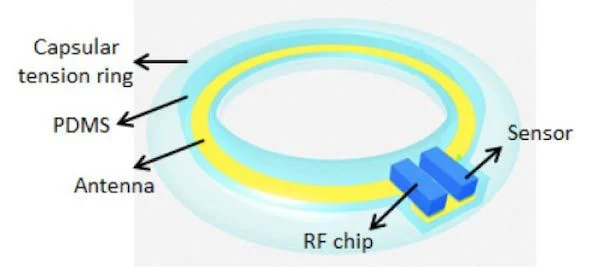An innovative low-power sensor designed by University of Washington engineers could someday be placed inside a person’s eye, tracking otherwise hard-to-measure eye pressure changes and transmitting the data wirelessly via radio frequency waves. Incorporated into an artificial intraocular lens, the sensor would be embedded during cataract surgery, making the replacement lens more functional.
Karl Böhringer, a UW professor of electrical engineering, pointed out that it was the first time electronics had been placed inside the eye’s lens. The team’s aim was to improve management of glaucoma and discover an easy way to monitor eye pressure, which can currently only be measured by an ophthalmologist,
Glaucoma damages the optic nerve of an eye causing blindness, yet people at risk of the disease may only receive pressure checks on a few occasions throughout the year.
Tueng Shen, a collaborator and UW professor of ophthalmology, explained that such an innovative pressure monitoring system could vastly enhance cataract surgery if the device is clinically adequate, reliable and simple in its design, so that all surgeons performing cataract surgeries can use it.
The prototype designed by the UW engineering team uses radio frequency for wireless power and data transfer and has a thin, circular antenna, which spans the perimeter of the device. By roughly tracing a person's iris, the device harnesses sufficient energy from the surrounding field to power a small pressure sensor chip. Communicating with a close-by receiver about any frequency shifts, the chip monitors changes in pressure, which are then calculated, tracked and recorded in real-time.
While the prototype in its current state is too large to fit into an artificial lens, it has successfully been embedded in the same flexible silicon material used to create artificial lenses in cataract surgeries. By downsizing the device further through engineering, the team is confident they will achieve their aim.
Böhringer described that the chip’s processor leaves the computational work to the nearby receiver, which could be integrated into a smartphone or be designed as a handheld unit.
Shen hopes the eye-integrated glaucoma monitor will allow treating patients before they are actually diagnosed with the disease. Eye pressure varies with a person’s activity levels, similar to blood pressure. If the pressure becomes too high, the optic nerve cannot function and without warning signs or pain, damage to the eye can unfold undetected.
As glaucoma and cataracts both affect the elderly, the researchers believe that it would be ideal to place the lens-incorporated monitoring device during a patient’s cataract surgery.
The project team, which includes Brian Otis, who is now with Google Inc., and Cagdas Varel and Yi-Chun Shih, both former doctoral students in electrical engineering, aim to make their invention affordable so that both surgeons and patients will welcome such a device.
The results of this research have recently been published in the Journal of Micromechanics and Microengineering and patents on the initial prototype have been filed.
Image credit: University of Washington
Image caption: An illustration of the final device. The device would be placed in an artificial lens with its antenna circling the perimeter, and the sensor and radio frequency chip inside.










